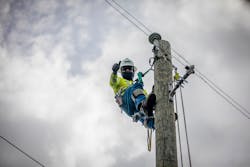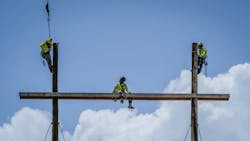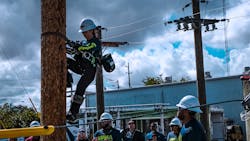Three hurricanes inflicted widespread power outages and significant infrastructure damage to Puerto Rico over the last six years. To keep the lights and power on to the communities, the 3,000 men and women of LUMA have focused on a more resilient, customer-focused and clean-energy system for the people of Puerto Rico.
When LUMA assumed operations in June 2021, the grid had suffered decades of neglect and lack of maintenance, said Dr. Shay Bahramirad, senior vice president, engineering, asset management and capital programs (now senior vice president, T&D, strategy and sustainability). Compounding the challenges, Hurricane Fiona caused $4 billion of damages and outages across the island less than a year later. Even so, the utility has made historic and lasting progress in just two years, she said.
“We have replaced over 5,000 poles, and by replacing them, we have brought them to industry best practices,” Bahramirad said. “These assets are going to withstand 169 mph winds. We have installed over 480 automatic outage reduction devices, and they are going to help us find where the outages are so we can restore customers in a timelier way. We’ve also cleared 1300 miles of hazardous vegetation.”
Due to these efforts from LUMA’s field workforce, the utility is seeing a 25 percent reduction in frequency and a 35 percent decline in the duration of outages. Over the last year, the utility has also connected 54,000 customers to rooftop solar, making Puerto Rico seventh among all U.S. states and territories in residential solar energy adoptions per capita.
“We are strengthening the entire system and improving overall resiliency and service for our customers, both now in the long term, for the generations to come,” Bahramirad said. “We want it to stand the test of time.”
The following is a glimpse into the progress Puerto Rico has made in its grid modernization projects and how its field workforce is helping to pave the way to reliability and resiliency.
Improving Reliability
After Hurricane Fiona flooded parts of Puerto Rico and left the island with a widespread blackout, LUMA’s field workforce has been focusing on clearing vegetation and restoring and rebuilding infrastructure. The utility is also continuing to partner with FEMA and the federal government to fund upcoming projects addressing generation shortfalls on the island. Case in point: the utility recently connected the first land-based generator funded by FEMA, which will add about 150 MW of generation and minimize the impact of generation-caused outages.
“We’re thinking holistically and methodically about how a modern grid should be built,” Bahramirad said. “This includes deploying a modern energy management system, deploying accurate system models and system planning, which never existed on the distribution level in Puerto Rico, and executing basic maintenance. That will lead to a stronger and more resilient electric system that delivers the safe and reliable energy that all Puerto Ricans deserve now and for the years to come.”
“Our customers are the core of everything we do,” Bahramirad said.
Clearing Vegetation
Another key focus of LUMA’s grid modernization plan is removing hazardous vegetation. Crews have removed vegetation surrounding more than 400 substations throughout the system to improve reliability.
“Vegetation is the number one cause of outages in Puerto Rico, and to date, we have cleared more than 1300 miles of power lines,” Bahramirad said. “We have prioritized clearing in areas where they are most needed, and where it will have the greatest impact on reliability and resiliency.”
To support its vegetation management efforts, the crews have been using a variety of technologies including drones, LiDAR and various cameras and sensors. To date, LUMA has patrolled and inspected 100 percent of its 115 kV and two 30 kV transmission lines across Puerto Rico using thermal imaging technology.
“The state of vegetation in Puerto Rico has given us a lot of opportunity for improvement,” Bahramirad said. “In other areas, the vegetation clearing we are doing is making it possible for us to execute the repairs and see more of the island. That way, we can avoid the outages and blackouts that have historically affected Puerto Rico.”
Upgrading Substations
To further improve reliability, LUMA is transitioning from stray bus, double ring or break-and-a-half to fully digitized substations through the $101 million FEMA-funded substation modernization initiative. The utility is focusing on modernizing 11 of its substations, and work is already underway on five of them. In the future, LUMA plans to bring in partners from across the United States and partner with local contractors to support the projects.
“We are working to not only restore, but fully rebuild and modernize each and every substation through the island, which will increase the safety of our operation,” Bahramirad said. “It will also reduce outages and improve energy reliability across the system for all our customers.”
Specifically, the crews are upgrading the oil circuit breakers with gas circuit breakers and elevating portions of the substations in the 10-year flood zone. In addition, LUMA is adding fiber optic technology for communication and deploying advanced sensors like phaser measurement units to improve situational awareness and wide area protection to provide enhanced resiliency.
“We are also looking at the system holistically to think about how we can plan the system in a matter that can improve the resiliency and sustainability of the whole system and enable more renewable energy on the island,” Bahramirad said. “When rebuilding the grid, we need to take the opportunity to use the best proven technology that meets the particular needs for each substation.”
This is particularly significant due to climate change, which is making the challenges LUMA and Puerto Rico are facing even more severe, she said. “We are located in a country in a hurricane zone, and what used to be a 500-year flood zone is now a 100-year or even a 50-year flood zone, and it requires the appropriate responses,” Bahramirad said.
In addition, LUMA is zoning in on the security and safety of its substations by clearing hazardous vegetation and conducting critical repair assessments of all the equipment. The utility is also working with local and federal law enforcement agencies to prevent the tampering of electrical equipment to protect the employees, contractors, customers and communities.
Spotlight on Streetlights and Solar
Beyond substation modernization, LUMA is focusing on replacing tens of thousands of streetlights through the $1 billion FEMA-funded initiative. Workers are installing more than 300,000 streetlights across the island’s 78 municipalities. LUMA’s crews, along with contractors, have replaced or repaired more than 37,000 streetlights so far.
Every new streetlight features LED technology, which uses about 65 percent less energy and lasts four times longer than conventional street light bulbs. “This is an important energy efficiency effort that will have a long-term benefit for Puerto Rico,” she said.
LUMA is working toward powering the communities with 100 percent clean energy, and as part of the initiative, the utility is focusing on rooftop solar. The utility has recently added 330 MW of clean energy to the grid.
“No one has done more on the ground to accelerate the clean energy transformation in Puerto Rico than LUMA,” she said. “All of this progress is thanks to the hard work of our 3,000 LUMA women and men who continue helping to connect more than 3,400 additional rooftop solar customers to the grid each month as we build a cleaner and more resilient energy system for Puerto Rico.”
Through the modernization projects, LUMA is focusing on the future of a grid that is reliable and resilient.
“Climate change means we need to expect more, and not fewer, disruptive events,” she said. “Everything we do is focused on ensuring the grid has the capabilities to withstand severe storms—from deploying poles that can withstand 160 mph wind to enhancing situational awareness with sensors and improving grid flexibility. Additionally, we are clearing vegetation to mitigate hazards and installing automated devices to restore power more quickly.”
By doing the projects the right way, LUMA can integrate the clean energy generation that can improve service for customers across Puerto Rico. “Building the grid in Puerto Rico is an opportunity to demonstrate how LUMA — and the industry as a whole — can make communities more reliable to drive economic activity and more sustainability and mitigate climate change and be more resilient in the face of a natural disaster.”
LUMA has already seen the results in Puerto Rico, which has had historic reductions in customer interruptions in less than two years of activity. “These successes have not only come from hard work at LUMA, but also close collaborations with stakeholders, and the local and federal government from FEMA and the Department of Energy to the leadership of various parts of the Puerto Rico government,” she said. “We have made incredible progress in just two years, but we know there is more work to be done. We are excited for what’s to come and the progress to be made in Puerto Rico in the years ahead.”
Juan Saca, the new president and CEO of LUMA, lived and worked in Puerto Rico from 2012 to 2019 during the period of Hurricane Maria and said he has a very special relationship to Puerto Rico and its people. Going forward, he plans to focus on three key priorities — communication, projects and stakeholder collaboration.
“The good news is that we have qualified personnel and federal and state funding to improve service,” he stated in a video message outlining his vision to LUMA’s customers. “Fortunately, several collaborators have joined us to replace more streetlights, install stronger poles, modernize substations and reduce the risk vegetation poses to power lines. Going forward, we will continue to be transparent about the opportunities and challenges we face. Together we will build a new era of progress for Puerto Rico.”
Amy Fischbach ([email protected]) is the Field Editor for T&D World magazine.
Editor’s Note: Listen to Part 1 and Part 2 of a Line Life podcast series to hear interviews with Dr. Shay Bahramirad from LUMA about the progress in grid modernization projects in Puerto Rico. You can also watch a video message from LUMA’s new president and CEO, Juan Saca, at https://youtu.be/zjLGvj_psPY.
By the Numbers: Training Lineworkers in Puerto Rico
With grid modernization projects underway across the island of Puerto Rico, LUMA Energy is investing in the future of its field workforce through LUMA College, the island’s first U.S. Department of Labor’s certified lineworker apprenticeship program. By partnering with the International Brotherhood of Electrical Workers, LUMA is training the employees necessary to modernize the grid.
To further increase the skilled labor talent in its pipeline, the utility recently opened doors to LUMA College’s new campus in Canóvanas. The utility also hired the first two female lineworkers in its history in 2022.
“The education we provide to our students and future lineworkers is based on industry-leading best practices,” said Juan Vargas, president of LUMA College. “The programs offered by LUMA College for Technical Training empowers a diverse and highly trained workforce to rebuild Puerto Rico’s electrical system.”
Here are some fast facts about the new campus, which offers classes in skilled labor, technical safety and line crew leadership.
- 24 acres with 18,000 sq ft of facilities
- 10-acre skills and competency yard
- Only transmission and distribution laboratory in the Caribbean and the fifth of its kind in the United States
- More than 3,000 utility workers have been trained through programs and training courses at LUMA College since 2021.
- 44 students have already graduated from a training program at the new campus.
- $12.5 million was donated by LUMA’s parent companies, Quanta and Atco, to build and construct the campus.
About the Author
Amy Fischbach
Electric Utilities Operations
Amy Fischbach is the Field Editor for T&D World magazine and manages the Electric Utility Operations section. She is the host of the Line Life Podcast, which celebrates the grit, courage and inspirational teamwork of the line trade. She also works on the annual Lineworker Supplement and the Vegetation Management Supplement as well as the Lineman Life and Lineman's Rodeo News enewsletters. Amy also covers events such as the Trees & Utilities conference and the International Lineman's Rodeo. She is the past president of the ASBPE Educational Foundation and ASBPE and earned her bachelor's and master's degrees in journalism from Kansas State University. She can be reached at [email protected].




